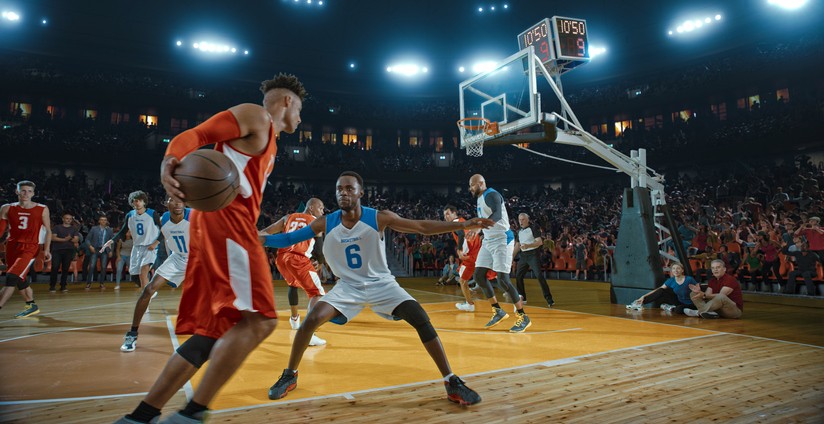Okay, Jordan fans! Hold up. Before you tie me up and burn me at the stake, hear me out!
Michael Jordan (also known as “MJ”, “Air Jordan”, “His Airness” and several other monikers) is certainly one of the most talented athletes to have ever played the game of basketball. During his 15 seasons in the NBA, Jordan won six NBA championship rings (all with the Chicago Bulls), won six NBA Finals Most Valuable Player (MVP) Awards, ten scoring titles, and five MVP Awards. In 1999, he was named the greatest North American athlete of the 20th century by ESPN. By the time Jordan left the league for the final time in 2003, (he retired a total of three times), he had scored a total of 32,292 points, and currently holds the #5 position on the all-time points scored in the NBA. Today, Jordan’s popularity with the fans remains as strong as ever. Just take a look at the frenzied mob bursting through the mall to purchase a pair of Jordan’s sneakers!
Steve Kerr, one of Jordan’s Chicago Bulls teammates, was also a respected basketball athlete and played a pivotal role in helping the Bulls establish their basketball dynasty in the 90s. In Game 6 of the 1997 NBA Championships, the Chicago Bulls were battling the Utah Jazz. The scores were tied at 86 with 28 seconds remaining. The Bulls called a timeout to discuss strategy. They knew that the Jazz would be expecting the Bulls to pass the ball to Michael Jordan (because, d’uh!), so they came up with a strategy. When play resumed, the Bulls did indeed pass the ball to Michael Jordan, but it was all a ruse. Jordan didn’t take the shot. Instead, with the Jazz double-teaming him, he passed the ball to Steve Kerr who was wide open. Kerr sunk a well-timed jumper – a major turning point in the game from which the Jazz couldn’t recover. The Bulls went on to win the game and their fifth championship. (p.s. you can watch the final seconds of that game by clicking this link.)
Before retiring in 2003, Steve Kerr went on to become a five-time NBA champion, having won three titles with the Chicago Bulls and two with the San Antonio Spurs. Kerr has the highest career three-point percentage (45.4%) in NBA history for any player with at least 250 three-pointers made.
Steve Kerr, was undoubtedly a talented and respected basketball athlete, but never reached the levels of stardom that Jordan reached. As of the publishing of this article, there are no reports of frenzied mobs breaking down the doors as they rush to purchase Steve Kerr sneakers.
So…why should branding professionals act more Steve Kerr? Glad you asked!
After Kerr retired from the NBA as a player, he returned to the game in 2014 as the head coach for the Golden State Warriors, where he became the first NBA rookie head coach to win 21 of his first 23 games. He was named the head coach of the Western Conference team for the 2015 NBA All-Star Game after Golden State had the best record in the conference. Kerr also became the fastest coach to win 300 games in professional sports history. And, as of the writing of this article, Kerr has led the Warriors to three NBA titles. in effect, Steve Kerr transitioned from being a star player to being a star coach who teaches other players how to win the game – a move that should inspire modern-day brand professionals.
Over the years, the game of branding has become incredibly complex and fraught with danger – especially in a world where constant digital connectivity threatens to shine a spotlight on every misstep that a brand may make.
In 2008, Canadian musician Dave Caroll and his band Sons of Maxwell were travelling on United Airlines from Halifax to Omaha. Caroll claims that, during the flight, the airline damaged his guitar and refused to accept liability or pay Caroll for the damages. So, Caroll and his band did what came naturally to them. They wrote a song about their experience with the airline and uploaded it to YouTube. The video went viral and the airline found itself being mercilessly needled online. Many observers believe that the resulting backlash from the incident was at least partially responsible for United Airlines losing 10 percent ($180 million) of its share values in 2009. This financial crisis was a direct result of the airline’s poor customer service and gives credibility to Whipple’s belief that brands are built from an amalgamation of customer experiences. Following the ridicule brought on by the release of the Sons of Maxwell music video, United Airlines reportedly offered to cover the cost of the broken guitar if the band agreed to remove the video from YouTube, but the band refused. The video is still online and, to date, it has racked up more than 20 million views!
Just two years before the United backlash, cable giant Comcast experienced a brand crisis as a result of the media firestorm which took place after a Comcast customer found one of the company’s technicians sleeping on the couch. The technician had come to fix the customer’s cable service, but decided to take a quick nap instead. The customer took a video of the sleeping technician and posted it online. The story was picked up by international media, including the NY Times and MSNBC. But, Comcast’s troubles didn’t end there.
In 2014, Comcast faced another round of backlash when customer Ryan Block posted a recording of his frustrating experience trying to cancel the company’s subscription. Instead of facilitating Block’s request, the Comcast representative went all out to block Block (tee hee) from leaving Comcast. Block does a terrific job of maintaining his cool while interacting with the Comcast rep, whose attitude bordered on being rude and insensitive towards Block’s request. To date, the audio recording has been played over 6 million times and has been the subject of international media attention. Commenting on the audio recording, the website TheVerge.com notes that “Comcast’s customer service nightmare is painful to hear.” The Guardian newspaper calls the customer service call “excruciating” and Time magazine quips that “If Dante’s Inferno had been written today, an extra circle of hell would be dedicated to dealings with cable providers.” Needless to say, all of the negative attention has caused Comcast’s brand to take a serious hit.
Here’s an example of a company that found itself in a crisis due not to poor customer experience, but due to its alleged toxic culture. Susan Fowler was a software engineer who spent a year working at Uber, one of the leading ride-hailing companies in the world. During her time at the company, Fowler alleges she experienced multiple episodes of unwanted sexual harassment. According to Fowler, her experience wasn’t unique. She claimed that several other female employees allegedly faced unwanted sexual advances from men in the company. After a year, in 2017, Fowler decided to leave Uber, after which she posted her article entitled Reflecting on one very, very strange year at Uber on her website. In her blog post, Fowler meticulously documents what she alleged to be the failure of the company’s leadership to address a culture of systematic sexism at Uber. Her coverage of Uber’s culture went viral and led to a series of events which eventually resulted in the ouster of Uber’s founder and CEO, Travis Kalanick.
In the face of such negative and widespread publicity about their respective levels of customer and employee experience, there was probably very little that the marketing departments of United, Comcast or Uber could have done to quell the crises that these companies had brought on themselves. Not even the most clever advertising campaigns would have hidden the fact that these companies needed to completely overhaul their employee and customer experience programs.
Modern branding professionals need to be able to adapt to this new environment where the hard work that they invest into developing creative marketing and advertising campaigns can easily be eviscerated by disgruntled customers and employees through the power of social media. And this calls for a more comprehensive approach to branding – one where companies view their brands not only based on the quality of their marketing and advertising initiatives, but also based on the quality of their customer experience and employee experience programs.

In much the same way that Steve Kerr transitioned from being a star player to being a star coach, modern-day branding professionals need to transition to a coaching role in which they help their colleagues in other departments to support their organizations’ branding initiatives. These professionals will need to work hand-in-hand with their customer experience colleagues to ensure that customer-facing staff provide the types of remarkable experiences that convert casual consumers into ‘raving fans’ of the brand. They will need to work with their organizations’ HR teams to craft employee experience programs that engage staff throughout the entire organization. They will need to work with their companies’ customer complaints department to ensure that the way complaints are resolved is in line with their organization’s desired brand positioning. They will need to work with their companies’ digital teams to ensure that customers’ digital experience on their companies’ websites and social media platforms support the work of the marketing department. And, this is just the tip of the iceberg! The branding professionals of tomorrow will likely need to work with, and coach, several other stakeholders to support their organizations’ overall branding strategy. That’s why branding professionals need to act more like Steve Kerr.
Okay, I admit it. The whole Steve Kerr/Michael Jordan analogy isn’t a perfect one. As the on-court leader of the Bulls, Michael Jordan would, undoubtedly, have facilitated his own unique style of coaching that helped drive his teammates towards excellence. So, in some ways, branding professionals still do need to emulate Michael Jordan’s on-court leadership. But, ignoring that teensy-weensy technicality, by now, you should see the point that article is trying to make – that modern-day branding professionals will need to be able to win the game of branding as both a star player and a star coach.
If you are a part of your organization’s branding team and you want to help your organization build a stronger brand and a stronger business, consider acting a little more like Steve Kerr. Reach out to your colleagues in other departments and include them in conversations about your organization’s brand strategy. Show them your brand playbook. Ask for their advice. Coach them on how they can do a better job of supporting your branding initiatives. You might be surprised to find out just how many people outside of your marketing department are willing and able to score the game-winning shot for your organization’s brand.

